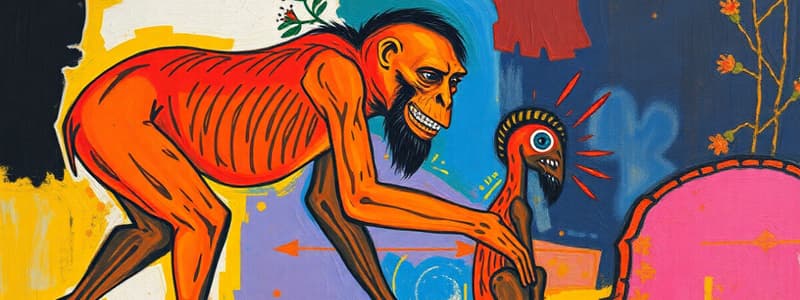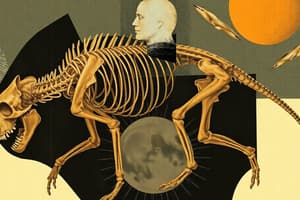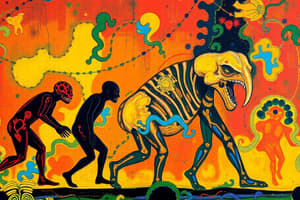Podcast
Questions and Answers
Which species is characterized by features indicating both walking and climbing adaptations?
Which species is characterized by features indicating both walking and climbing adaptations?
- Paranthropus
- Kenyanthropus
- Ardipithecus ramidus (correct)
- Australopithecus afarensis
What evidence do paleontologists often rely on when analyzing ancient hominins?
What evidence do paleontologists often rely on when analyzing ancient hominins?
- Complete skeletal remains
- DNA analysis from fossil samples
- Measurements of skulls, teeth, or jaws (correct)
- Cultural artifacts found with fossils
What is a key concept regarding the evolutionary process of hominins?
What is a key concept regarding the evolutionary process of hominins?
- Hominin evolution is a linear progression towards modern humans.
- Modern humans evolved directly from Australopithecus afarensis.
- Hominin evolution reflects a process of diversification with several lineages. (correct)
- All hominins that once existed have left living descendants today.
What historical evidence shows the presence of Australopithecus afarensis around 3.6 million years ago?
What historical evidence shows the presence of Australopithecus afarensis around 3.6 million years ago?
What distinguishes robust Australopithecines, such as Paranthropus, from other hominin lineages?
What distinguishes robust Australopithecines, such as Paranthropus, from other hominin lineages?
What is the primary benefit of forming a supergene from well-adapted traits?
What is the primary benefit of forming a supergene from well-adapted traits?
What is a significant cost associated with mate searching in sexually reproducing individuals?
What is a significant cost associated with mate searching in sexually reproducing individuals?
How does mating with larger males affect female beetles in terms of predation risk?
How does mating with larger males affect female beetles in terms of predation risk?
What is a potential consequence of organisms mating concerning diseases?
What is a potential consequence of organisms mating concerning diseases?
Which of the following statements best explains Muller's Ratchet?
Which of the following statements best explains Muller's Ratchet?
What overall effect does recombination have on offspring fitness when traits are well adapted?
What overall effect does recombination have on offspring fitness when traits are well adapted?
What is one major energetic cost associated with sexual reproduction?
What is one major energetic cost associated with sexual reproduction?
What describes the mutational mode in evolving populations?
What describes the mutational mode in evolving populations?
What is one primary adaptation of early hominins that is highlighted in the content?
What is one primary adaptation of early hominins that is highlighted in the content?
What is the overall effect of deleterious mutations on the genome referred to as?
What is the overall effect of deleterious mutations on the genome referred to as?
Which species is described as being discovered by an all-women team of paleoanthropologists?
Which species is described as being discovered by an all-women team of paleoanthropologists?
What concept explains the small size of Homo floresiensis due to limited resources on islands?
What concept explains the small size of Homo floresiensis due to limited resources on islands?
What happens to the minimum number of mutations across a population as new deleterious mutations accumulate?
What happens to the minimum number of mutations across a population as new deleterious mutations accumulate?
Why can the ratchet mechanism only turn in one direction?
Why can the ratchet mechanism only turn in one direction?
How long ago did Homo floresiensis live, according to the content?
How long ago did Homo floresiensis live, according to the content?
What is stated about early hominins and their relationship to modern humans?
What is stated about early hominins and their relationship to modern humans?
How many new deleterious mutations do humans typically carry that are absent in their parents?
How many new deleterious mutations do humans typically carry that are absent in their parents?
What is the primary advantage of recombination in sexually reproducing lineages?
What is the primary advantage of recombination in sexually reproducing lineages?
What distinguishes Homo naledi from other early hominins?
What distinguishes Homo naledi from other early hominins?
What is the main implication of Muller's ratchet on populations reproducing asexually?
What is the main implication of Muller's ratchet on populations reproducing asexually?
Which statement about the genus Homo is correct based on the content?
Which statement about the genus Homo is correct based on the content?
What is indicated about the existence of different hominin lineages?
What is indicated about the existence of different hominin lineages?
What hypothesis describes how recombination facilitates faster adaptation by combining beneficial mutations?
What hypothesis describes how recombination facilitates faster adaptation by combining beneficial mutations?
What effect does increasing frequencies of specific adaptive alleles have on asexually reproducing populations?
What effect does increasing frequencies of specific adaptive alleles have on asexually reproducing populations?
What significant evolutionary feature is primarily associated with early hominins?
What significant evolutionary feature is primarily associated with early hominins?
Which species is identified as the first wave out of Africa?
Which species is identified as the first wave out of Africa?
What is a major change that was observed in hominin evolution?
What is a major change that was observed in hominin evolution?
What adaptation did Homo erectus possess to facilitate its long-distance travel?
What adaptation did Homo erectus possess to facilitate its long-distance travel?
During which time period did Neanderthals predominantly inhabit Eurasia?
During which time period did Neanderthals predominantly inhabit Eurasia?
Which climatic change is suggested to have influenced the evolution of bipedalism?
Which climatic change is suggested to have influenced the evolution of bipedalism?
When did modern humans begin to disperse out of Africa?
When did modern humans begin to disperse out of Africa?
What characteristic differentiates Neanderthals from modern humans?
What characteristic differentiates Neanderthals from modern humans?
What is Clonal Interference?
What is Clonal Interference?
Which advantage does sexual reproduction have over asexual reproduction?
Which advantage does sexual reproduction have over asexual reproduction?
What role does bet hedging play in sexual reproduction?
What role does bet hedging play in sexual reproduction?
How does asexual reproduction impact the mutation load in a population?
How does asexual reproduction impact the mutation load in a population?
What is the significance of host-parasite interactions in sexual reproduction?
What is the significance of host-parasite interactions in sexual reproduction?
How does sexual reproduction facilitate the formation of a super genome?
How does sexual reproduction facilitate the formation of a super genome?
Why might an asexual population initially outperform a sexual population?
Why might an asexual population initially outperform a sexual population?
What happens to asexual lineages under strong selection pressure?
What happens to asexual lineages under strong selection pressure?
Flashcards
Clonal Interference
Clonal Interference
A phenomenon where beneficial mutations compete with each other for dominance within a genome due to the inability of asexual reproduction to combine them.
Recombination
Recombination
The process of combining genetic material from two parents, leading to diverse offspring in sexual reproduction.
Fixation
Fixation
A beneficial mutation becoming dominant in a population due to its increased fitness, often eliminating competing mutations.
Hitchhiking
Hitchhiking
Signup and view all the flashcards
Mutation Load
Mutation Load
Signup and view all the flashcards
Bet Hedging
Bet Hedging
Signup and view all the flashcards
Red Queen Hypothesis
Red Queen Hypothesis
Signup and view all the flashcards
Host-Parasite Coevolution
Host-Parasite Coevolution
Signup and view all the flashcards
Ardipithecus ramidus
Ardipithecus ramidus
Signup and view all the flashcards
Gracile Australopithecines
Gracile Australopithecines
Signup and view all the flashcards
Australopithecus afarensis footprints in ash
Australopithecus afarensis footprints in ash
Signup and view all the flashcards
Robust Australopithecines (Paranthropus)
Robust Australopithecines (Paranthropus)
Signup and view all the flashcards
Hominin Evolution is Not Linear
Hominin Evolution is Not Linear
Signup and view all the flashcards
Early Homo
Early Homo
Signup and view all the flashcards
Homo Naledi
Homo Naledi
Signup and view all the flashcards
Island Dwarfism
Island Dwarfism
Signup and view all the flashcards
Archaic Hominins
Archaic Hominins
Signup and view all the flashcards
Megadonts
Megadonts
Signup and view all the flashcards
Recent Hominin Extinction
Recent Hominin Extinction
Signup and view all the flashcards
Hominin Evolution
Hominin Evolution
Signup and view all the flashcards
African Origin of Hominins
African Origin of Hominins
Signup and view all the flashcards
Homo Erectus
Homo Erectus
Signup and view all the flashcards
Bipedalism
Bipedalism
Signup and view all the flashcards
Australopithecus afarensis
Australopithecus afarensis
Signup and view all the flashcards
Cranial Capacity
Cranial Capacity
Signup and view all the flashcards
Neanderthals
Neanderthals
Signup and view all the flashcards
Out-of-Africa Dispersal
Out-of-Africa Dispersal
Signup and view all the flashcards
Genomics
Genomics
Signup and view all the flashcards
Muller's Ratchet
Muller's Ratchet
Signup and view all the flashcards
Ratchet Turning
Ratchet Turning
Signup and view all the flashcards
Click of the Ratchet
Click of the Ratchet
Signup and view all the flashcards
Fisher-Muller Hypothesis
Fisher-Muller Hypothesis
Signup and view all the flashcards
Recombination Unclicks the Ratchet
Recombination Unclicks the Ratchet
Signup and view all the flashcards
Mutation Fixation
Mutation Fixation
Signup and view all the flashcards
Chromosomal Inversion
Chromosomal Inversion
Signup and view all the flashcards
Supergene
Supergene
Signup and view all the flashcards
Inversion and Recombination
Inversion and Recombination
Signup and view all the flashcards
Cost of Mate Searching
Cost of Mate Searching
Signup and view all the flashcards
Mate Choice and Predation
Mate Choice and Predation
Signup and view all the flashcards
Sex and Disease Transmission
Sex and Disease Transmission
Signup and view all the flashcards
Mutations
Mutations
Signup and view all the flashcards
Cost of Recombination
Cost of Recombination
Signup and view all the flashcards
Study Notes
Why do organisms reproduce sexually?
- Reproduction is paradoxical, costly in many ways
- Asexual reproduction is better for organisms evolutionarily
- Sexual reproduction ultimately is better
- Most species in the tree of life reproduce sexually
- Sharing genetic material and recombination are key to sexual reproduction
"Twiggy" Phylogenetic Distribution of Asexuality
- Asexual lineages spontaneously appear on the tree of life, but are usually short-lived
- Lizards provide an example
- Sometimes asexuality offers an advantage over sexual reproduction
Types of Asexual Reproduction - Apomictic Parthenogenesis
- A form of asexual reproduction, common in whiptail lizards and some New Zealand mud snails
- Diploid cells undergo mitosis, not meiosis, creating eggs without genetic contribution from a male
Gynogenesis
- Similar to apomictic parthenogenesis on a cellular level
- Requires a male to stimulate egg production; sperm only necessary for initiating mitosis, not contributing genetically
- Supports the idea of recent evolution of asexuality
Independent Evolutions
- Independent evolutions of asexual reproduction in related but not identical species
- Female diploid having genetic contributions from both parents
- Kick out of the male maternal genome for reproduction to continue
Sexual Reproduction
- In meiosis, a reduction in copy number occurs, diploid adults make haploid gametes with genetic material from both parents
- Genetic shuffling is key to sexual difference
- Horizontal gene transfer is extreme example of asexuality
- Sexual reproduction involves recombination and genetic material exchange
The Cost of Sex
- Anisogamy: different investment in male vs female gametes; female investment for egg production is high
- Two-fold reproductive cost of sexual reproduction due to anisogamy
Costs of Sex
- Sexually transmitted diseases and parasites: transmission probability increases
- Finding mates takes energy
- Breaking up favorable gene combinations
Benefits of Sex
- Muller's Ratchet and Mutational Load: reduces accumulation of deleterious mutations in asexually reproducing organisms due to limited recombination
- Recombination facilitates faster adaptation to changing circumstances; beneficial mutations get combined.
Testing the Benefits of Sex: Experiments
- Did a study showing reduced fitness for asexually reproducing yeast
- Genetically variable offspring in sexual reproduction may be an advantage in a fluctuating environment
Adapting to Changing Circumstances
- Sexual reproduction aids adaptability to environmental changes and competition, offering offspring diversity.
- Variability in offspring is an advantage in changing circumstances
Red Queen: Outrunning Parasites
- Sex aids in keeping up with evolving parasites and pathogens in a coevolutionary arms race.
Tests with New Zealand Snails
- Snails may be entirely asexual with only females
- Asexual reproduction is dominant in snails with higher parasite prevalence
What is Sexual Selection?
- Competition for mates; determines who gets to reproduce
- Variances in mating success
- Sexual Selection - individuals of one sex are more competitive for the opportunity to mate
Types of Sexual Selection
- Intersexual Selection: mate choice
- Intrasexual Selection: male-male competition
Sexual Conflict
- Different mating interests from males and females
Humans as Primates
- Nearly all apes are found in Africa
- Hominins are the lineage closest to modern humans
Interbreeding and Introgression
- Constant mixing of gene pools between and within species
Our Closest Extinct Relatives
- Hominins lineages that have gone extinct, but were relatively close to modern humans
Incomplete Lineage Sorting
- Gene trees may not match the species tree if speciation events are close in time
Testing Evolutionary Hypotheses of Common Ancestry
- Using evidence to show links and relationships among species
Humans and other hominins
- Early lineages that were possibly early hominin
Evolution and Behavior
- Evolution of sexual reproduction varies
- Adaption to climate and environment affect evolutionary selection outcomes
- Human diversity in terms of genetic background
Evolvability of Infectious Diseases
- Evolutionary pressures result in pathogen resistance to treatments
- Understanding genetic and environmental influences on pathogens aids treatment strategies.
Studying That Suits You
Use AI to generate personalized quizzes and flashcards to suit your learning preferences.




